Pedagogical Resources for Conducting STEM Engineering Projects in Chemistry Teacher Education: A Design-Based Research Approach
Abstract
1. Introduction
2. Design-Based Research Approach
2.1. Design Procedure
2.2. Research Questions
- RQ1: What are the best practices for implementing an engineering approach in STEM projects as part of chemistry teacher education?
- RQ2: What kind of assessment tool can be used to evaluate STEM projects conducted by future chemistry teachers?
3. Theoretical Problem Analysis
3.1. Engineering Approach
- Concept synthesis.
- Concept evaluation.
- Concept selection and production.
3.2. Project-Based Learning and Assessment in STEM Education
- Scaffolds need to be tailored to a student’s current level of understanding.
- Scaffolds should be phased out over time as students learn to apply the new knowledge or skills on their own.
- Clarify and share learning goals and criteria for success with students.
- Design and implement classroom activities that elicit evidence of student understanding.
- Give constructive feedback that helps students move forward.
- Activate students as instructional resources for one another, for example, through peer evaluation.
- Support students’ authority over their own learning, for example, through self-evaluation.
4. Empirical Problem Analysis
4.1. Research Setting
4.1.1. Phase 1: Theory and Arduino
4.1.2. Phase 2: Project Ideas
4.1.3. Phase 3: Engineering Approach
4.1.4. Phase 4: Seminar and Peer-Reviewed Article
- The sources and modes of gathering the initial product ideas.
- The challenges encountered during the design and build process.
- The educational setups planned for the use of the developed prototype.
- The modes and means of inter-peer and other cooperation on the path from the idea to the finished product.
- The use of AI tools to help with coding and writing.
4.2. Data Gathering
- “Now that you have nearly finished the course, can you tell us what the most difficult challenge was that you faced?”
- “What are the most important new skills that you acquired during the course?”
- “If you look back at the device you made, how important do you think the systematic engineering approach was in bringing it to fruition?”
- “Can you describe a typical educational setup in which you plan to use your device?”
4.3. Data Analysis
5. Results and Discussion
5.1. Design Solution 1: Best Practices for Teaching an Engineering Approach (RQ1)
- Recommendation 1: Support the progress of an engineering approach
“I didn’t really understand it at first, but now that I’ve done that once, I think it really helped to, like, to come up with the best kind of solution or … how I could take it further after… this one prototype. So, I think it was hard at first, but it helped me to think at the end.”R3
“I found it really helpful, and especially you had a chance to engage with different kinds of concepts and compare them, which was super good because easily you would just go down one route and not really compare, like, any alternatives.”R1
“It felt a bit confusing at first, but it was really helpful to start to, like, I don’t know, to, like, divide this bigger project into smaller parts. So, in that way it helped to create the abstract idea for the concrete thing. … And with this process, I feel like I … can also justify for myself why I made certain decisions.”R2
“I think it was useful, but since … I got a very clear vision already in the first phase, when I started planning the project … I didn’t feel all these steps were so necessary, particularly for… me. But yeah, they were … useful, but not necessary in my case.”R5
“…as a concept, all of these phases together, I found them very interesting. And actually, I thought maybe I might use it in the future in some cases for myself.”R5
- Recommendation 2: Support the selection of design context
“Probably the most difficult part was just to pick the subject you’re going to work on.”R3
“I would say the most difficult part was to get the idea …”R2
“I had a few different ideas, and I started narrowing them down with what I found to be the most, either interesting … and also … what was something I was definitely able to do…”R5
“I searched for a couple of reference projects, and I tried to look at the equipment from them, but they were pretty different from the one I had originally searched for, so I just pretty much asked my friends what they did. So, my friends were the main source for my information.”R6
“Yeah, the initial idea was from my brother. … Actually, I … managed to go by myself, but basically I … just told him that I chose his idea but … I didn’t really use his help with the project.”R4
- Recommendation 3: Support the usage of generative AI
“…the coding … part, if we want to be very specific, it was the most challenging one.”R3
- Recommendation 4: Contact teaching and instructor guidance are important
“I think in the beginning it was hard to, like, think about how to make the … equipment stuff because I didn’t really know anything about … engineering…”R1
- Recommendation 5: Support for collaboration and connectivity between projects
5.2. Design Solution 2: Evaluation Matrix for STEM Projects (RQ2)
“I think it looks … solid, like having both parts, like preparing … the idea and then, like, actually applying the idea. Like, I think there’s a pretty good balance in different … points of view.”R6
“I think it looks good and it’s, like … it emphasizes that there is so much more than just building the device and having it be ready…”R2
“It … seems … pretty good since it measures many, many, many parts of the … designing process.”R1
“Yeah, it looks like it [is a fair way of grading]. Yeah, at least if the … if it is somehow shared in advance, what is to be evaluated, yeah?”R4
“I like this chart … and next time also, it would be very good to point out this at the beginning of the course, that there is a valuation for every single phase.”R6
6. Discussion and Conclusions
Author Contributions
Funding
Institutional Review Board Statement
Informed Consent Statement
Data Availability Statement
Acknowledgments
Conflicts of Interest
Abbreviations
| AI | Artificial intelligence |
| DBR | Design-based research |
| PBL | Project-based learning |
| SBC | Single Board Computer |
| STEM | Science, Technology, Engineering, and Mathematics |
| TPACK | Technological (TK), Pedagogical (PK), and (A) Content Knowledge (CK) |
Appendix A. Feedback Form
Appendix B. Engineering Approach Template
Appendix C. Evaluation Matrix
References
- Ambrož, M., & Pernaa, J. (2025a). Engineering approach excel template (version 1). Zenodo. [Google Scholar] [CrossRef]
- Ambrož, M., & Pernaa, J. (2025b). Evaluation matrix excel template for engineering projects in higher education (version 1). Zenodo. [Google Scholar] [CrossRef]
- Ambrož, M., & Pernaa, J. (2025c). TEKO 2024 feedback form. Zenodo. [Google Scholar] [CrossRef]
- Ambrož, M., Pernaa, J., Haatainen, O., & Aksela, M. (2023). Promoting STEM education of future chemistry teachers with an engineering approach involving single-board computers. Applied Sciences, 13(5), 3278. [Google Scholar] [CrossRef]
- Anderson, T., & Shattuck, J. (2012). Design-based research a decade of progress in education research? Educational Researcher, 41(1), 16–25. [Google Scholar] [CrossRef]
- Aslam, S., Alghamdi, A. A., Abid, N., & Kumar, T. (2023). Challenges in implementing STEM education: Insights from novice STEM teachers in developing countries. Sustainability, 15(19), 14455. [Google Scholar] [CrossRef]
- Baze, C. L., González-Howard, M., Sampson, V., Crawford, R., & Hamilton, X. (2025). “Okay we’re doing my idea”: How students enact epistemic agency and power in a design-based engineering context. Education Sciences, 15(4), 402. [Google Scholar] [CrossRef]
- Black, P., & Wiliam, D. (2009). Developing the theory of formative assessment. Educational Assessment, Evaluation and Accountability, 21(1), 5–31. [Google Scholar] [CrossRef]
- Carless, D. (2019). Feedback loops and the longer-term: Towards feedback spirals. Assessment & Evaluation in Higher Education, 44(5), 705–714. [Google Scholar] [CrossRef]
- Cheng, M.-F., Lo, Y.-H., & Cheng, C.-H. (2024). The impact of STEM curriculum on students’ engineering design abilities and attitudes toward STEM. International Journal of Technology and Design Education, 34(1), 805–1833. [Google Scholar] [CrossRef]
- Christian, K. B., Kelly, A. M., & Bugallo, M. F. (2021). NGSS-based teacher professional development to implement engineering practices in STEM instruction. International Journal of STEM Education, 8(1), 21. [Google Scholar] [CrossRef]
- Cohen, L., Manion, L., & Morrison, K. (2018). Research methods in education (8th ed). Routledge. [Google Scholar]
- Condliffe, B., Quint, J., Visher, M. G., Bangser, M. R., Drohojowska, S., Saco, L., & Nelson, E. (2017). Project-based learning a literature Review (Publications Working paper). MDRC. Available online: https://www.mdrc.org/sites/default/files/Project-Based_Learning-LitRev_Final.pdf (accessed on 28 August 2025).
- Dolgopolovas, V., & Dagienė, V. (2021). Computational thinking: Enhancing STEAM and engineering education, from theory to practice. Computer Applications in Engineering Education, 29(1), 5–11. [Google Scholar] [CrossRef]
- Edelson, D. C. (2002). Design research: What we learn when we engage in design. Journal of the Learning Sciences, 11(1), 105–121. [Google Scholar] [CrossRef]
- El Nagdi, M., Leammukda, F., & Roehrig, G. (2018). Developing identities of STEM teachers at emerging STEM schools. International Journal of STEM Education, 5(1), 36. [Google Scholar] [CrossRef]
- García-Carmona, A., & Toma, R. B. (2024). Integration of engineering practices into secondary science education: Teacher experiences, emotions, and appraisals. Research in Science Education, 54, 549–572. [Google Scholar] [CrossRef]
- Güder, Y., & Gürbüz, R. (2022). Products from building an engineering model for stem education activity. Cukurova University Faculty of Education Journal, 51(3), 1552–1583. [Google Scholar] [CrossRef]
- Haatainen, O., & Aksela, M. (2021). Project-based learning in integrated science education: Active teachers’ perceptions and practices. LUMAT: International Journal on Math, Science and Technology Education, 9(1), 149–173. [Google Scholar] [CrossRef]
- Halawa, S., Lin, T.-C., & Hsu, Y.-S. (2024). Exploring instructional design in K-12 STEM education: A systematic literature review. International Journal of STEM Education, 11(1), 43. [Google Scholar] [CrossRef]
- Hallström, J., Norström, P., & Schönborn, K. J. (2023). Authentic STEM education through modelling: An international Delphi study. International Journal of STEM Education, 10(1), 62. [Google Scholar] [CrossRef]
- Hellum, V., Heimdal, A., & Lande, I. (2024). Different assessment methods in a civil engineering course. Nordic Journal of STEM Education, 8(1), 1. [Google Scholar] [CrossRef]
- Juuti, K., & Lavonen, J. (2006). Design-based research in science education: One step towards methodology. Nordic Studies in Science Education, 2(2), 54–68. [Google Scholar] [CrossRef]
- Karakasic, M., Zadnik, Z., Kljajin, M., & Duhovnik, J. (2018). The matrix of function and functionality in product development process. International Journal of Simulation Modelling, 17(3), 391–404. [Google Scholar] [CrossRef]
- Kemppainen, K. (2025). Maillard-reaktion lämpötilan tutkiminen kemian opetuksessa Arduino-kehitysalustalla [Investigating the Maillard reaction temperature in chemistry education using the Arduino platform]. LUMAT-B: International Journal on Math, Science and Technology Education, 10(1), 3. Available online: https://urn.fi/urn:nbn:fi:hulib:editori:lumatb.v10i1.26897 (accessed on 28 August 2025).
- Koehler, M., & Mishra, P. (2005). What happens when teachers design educational technology? The development of technological pedagogical content knowledge. Journal of Educational Computing Research, 32(2), 131–152. [Google Scholar] [CrossRef]
- Koehler, M., & Mishra, P. (2009). What is technological pedagogical content knowledge (TPACK)? Contemporary Issues in Technology and Teacher Education, 9(1), 60–70. [Google Scholar] [CrossRef]
- Kokotsaki, D., Menzies, V., & Wiggins, A. (2016). Project-based learning: A review of the literature. Improving Schools, 19(3), 267–277. [Google Scholar] [CrossRef]
- Maiorca, C., & Mohr-Schroeder, M. J. (2020). Elementary preservice teachers’ integration of engineering into STEM lesson plans. School Science and Mathematics, 120(7), 402–412. [Google Scholar] [CrossRef]
- Mentzer, G. A., Czerniak, C. M., & Brooks, L. (2017). An examination of teacher understanding of project based science as a result of participating in an extended professional development program: Implications for implementation. School Science and Mathematics, 117(1–2), 76–86. [Google Scholar] [CrossRef]
- Mishra, P., & Koehler, M. J. (2006). Technological pedagogical content knowledge: A framework for teacher knowledge. Teachers College Record, 108(6), 1017–1054. [Google Scholar] [CrossRef]
- Mumba, F., Rutt, A., Bailey, R., Pottmeyer, L., Van Aswegen, R., Chiu, J., & Ojeogwu, J. (2024). A model for integrating engineering design into science teacher education. Journal of Science Education and Technology, 33(1), 45–56. [Google Scholar] [CrossRef]
- Navy, S. L., & Kaya, F. (2020). PBL as a pedagogical approach for integrated STEM: Evidence from prospective teachers. School Science and Mathematics, 120(5), 285–296. [Google Scholar] [CrossRef]
- Offerdahl, E. G., McConnell, M., & Boyer, J. (2018). Can I have your recipe? Using a fidelity of implementation (FOI) framework to identify the key ingredients of formative assessment for learning. CBE—Life Sciences Education, 17(4), es16. [Google Scholar] [CrossRef]
- Ojala, E. (2025). Arduino-kosteusmittarin hyödyntäminen lukion kemian opetuksessa [The utilization of an Arduino moisture meter in upper secondary school chemistry teaching]. LUMAT-B: International Journal on Math, Science and Technology Education, 10(1), 4. Available online: https://urn.fi/urn:nbn:fi:hulib:editori:lumatb.v10i1.26906 (accessed on 28 August 2025).
- OpenAI. (2022, November 30). Introducing ChatGPT. Available online: https://openai.com/blog/chatgpt (accessed on 1 April 2025).
- Ozkizilcik, M., & Cebesoy, U. B. (2024). The influence of an engineering design-based STEM course on pre-service science teachers’ understanding of STEM disciplines and engineering design process. International Journal of Technology and Design Education, 34(2), 727–758. [Google Scholar] [CrossRef]
- Öörni, R. (2024). Saavutettava pH-säädin kemian opetukseen: Arduino-kehitysprojekti [Accessible pH controller for chemistry education]. LUMAT-B: International Journal on Math, Science and Technology Education, 9(1), 51–67. Available online: https://urn.fi/urn:nbn:fi:hulib:editori:lumatb.v9i1.22412 (accessed on 17 August 2025).
- Pernaa, J. (2024). Dataset for an article “Developing best practices for conducting STEM engineering projects in higher education” (Repository). Zenodo. Available online: https://zenodo.org/records/14035448 (accessed on 17 August 2025).
- Pernaa, J., Ikävalko, T., Takala, A., Vuorio, E., Pesonen, R., & Author, O. (2024). Artificial intelligence chatbots in chemical information seeking: Narrative educational insights via a SWOT analysis. Informatics, 11(2), 20. [Google Scholar] [CrossRef]
- Pernaa, J., & Wiedmer, S. (2019). A systematic review of 3D printing in chemistry education–analysis of earlier research and educational use through technological pedagogical content knowledge framework. Chemistry Teacher International, 2(2), 20190005. [Google Scholar] [CrossRef]
- Roiha, M. (2024). Automaattinen pH-säädin Arduino-ohjelmistoympäristössä kemian opetukseen [Automatic pH controller in the Arduino software environment for chemistry teaching]. LUMAT-B: International Journal on Math, Science and Technology Education, 9(1), 28–50. Available online: https://urn.fi/urn:nbn:fi:hulib:editori:lumatb.v9i1.22408 (accessed on 17 August 2025).
- Sandoval, W. A. (2004). Developing learning theory by refining conjectures embodied in educational designs. Educational Psychologist, 39(4), 213–223. [Google Scholar] [CrossRef]
- Savery, J. R. (2019). Comparative pedagogical models of problem-based learning. In M. Moallem, W. Hung, & N. Dabbagh (Eds.), The wiley handbook of problem-based learning (1st ed., pp. 81–104). Wiley. [Google Scholar] [CrossRef]
- Taponen, A. (2024). Vesiliuoksen suolaisuuden mittaaminen Arduino-kehitysalustalla [Measuring water salinity using an Arduino development platform]. LUMAT-B: International Journal on Math, Science and Technology Education, 9(1), 16–27. Available online: https://urn.fi/urn:nbn:fi:hulib:editori:lumatb.v9i1.22427 (accessed on 16 May 2025).
- The Design-Based Research Collective. (2003). Design-based research: An emerging paradigm for educational inquiry. Educational Researcher, 32(1), 5–8. [Google Scholar] [CrossRef]
- Tuomi, J., & Sarajärvi, A. (2018). Laadullinen tutkimus ja sisällönanalyysi [Qualitative research and content analysis]. Tammi. [Google Scholar]
- Turpeinen, J. (2025). Lämpömäärämittari kemiallisen reaktion energiamuutosten määritykseen Arduino-ohjelmistoympäristössä [Calorimeter for determining energy changes in chemical reactions within the Arduino software environment]. LUMAT-B: International Journal on Math, Science and Technology Education, 10(1), 2. Available online: https://urn.fi/urn:nbn:fi:hulib:editori:lumatb.v10i1.26917 (accessed on 17 August 2025).
- Zadnik, Ž., Karakašić, M., Kljajin, M., & Duhovnik, J. (2009). Function and functionality in the conceptual design process. Journal of Mechanical Engineering, 55(7–8), 455–471. [Google Scholar]
- Zaher, A. A., & Damaj, I. W. (2018). Extending STEM education to engineering programs at the undergraduate college level. International Journal of Engineering Pedagogy (iJEP), 8(3), 4–16. [Google Scholar] [CrossRef]
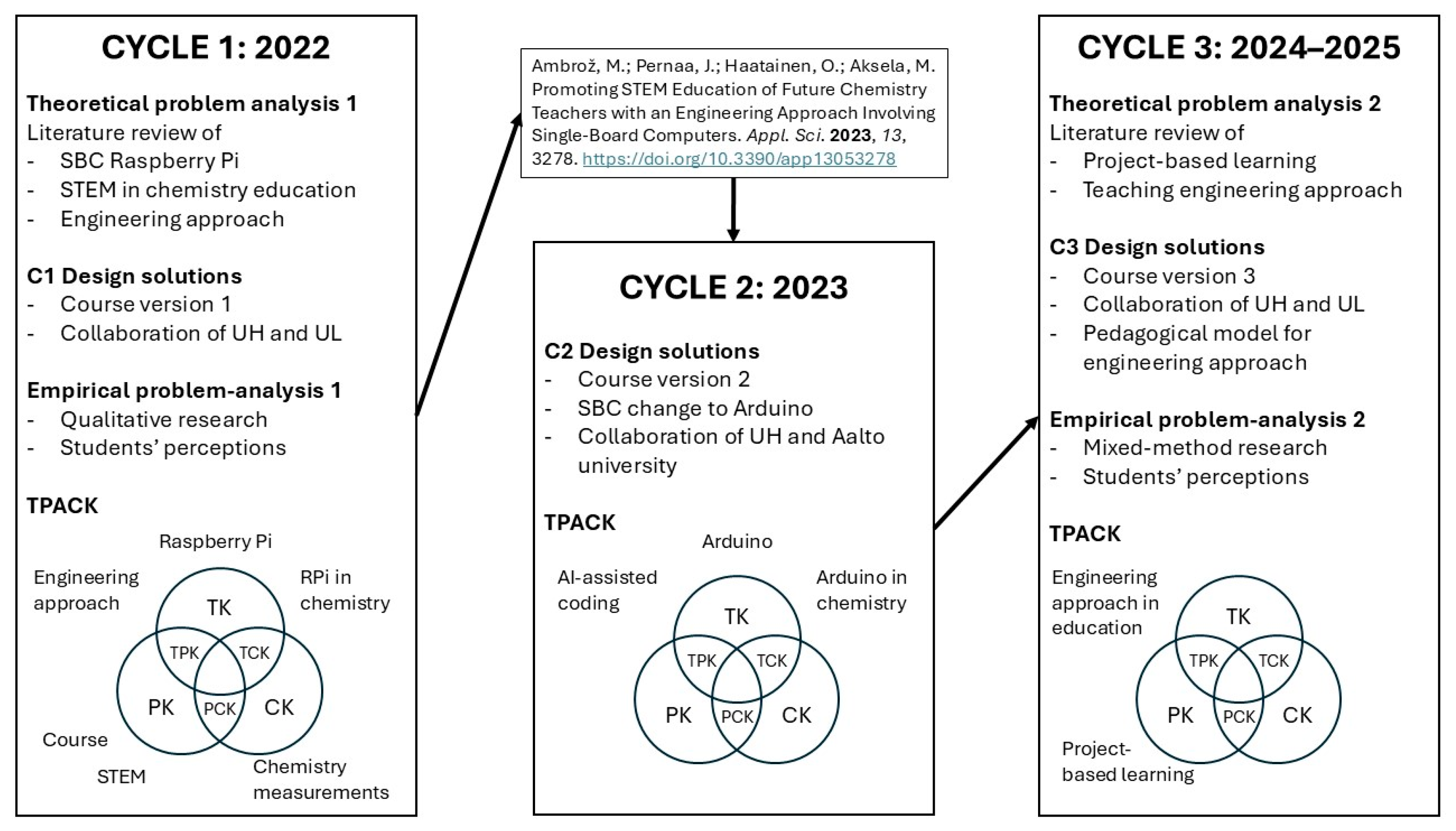


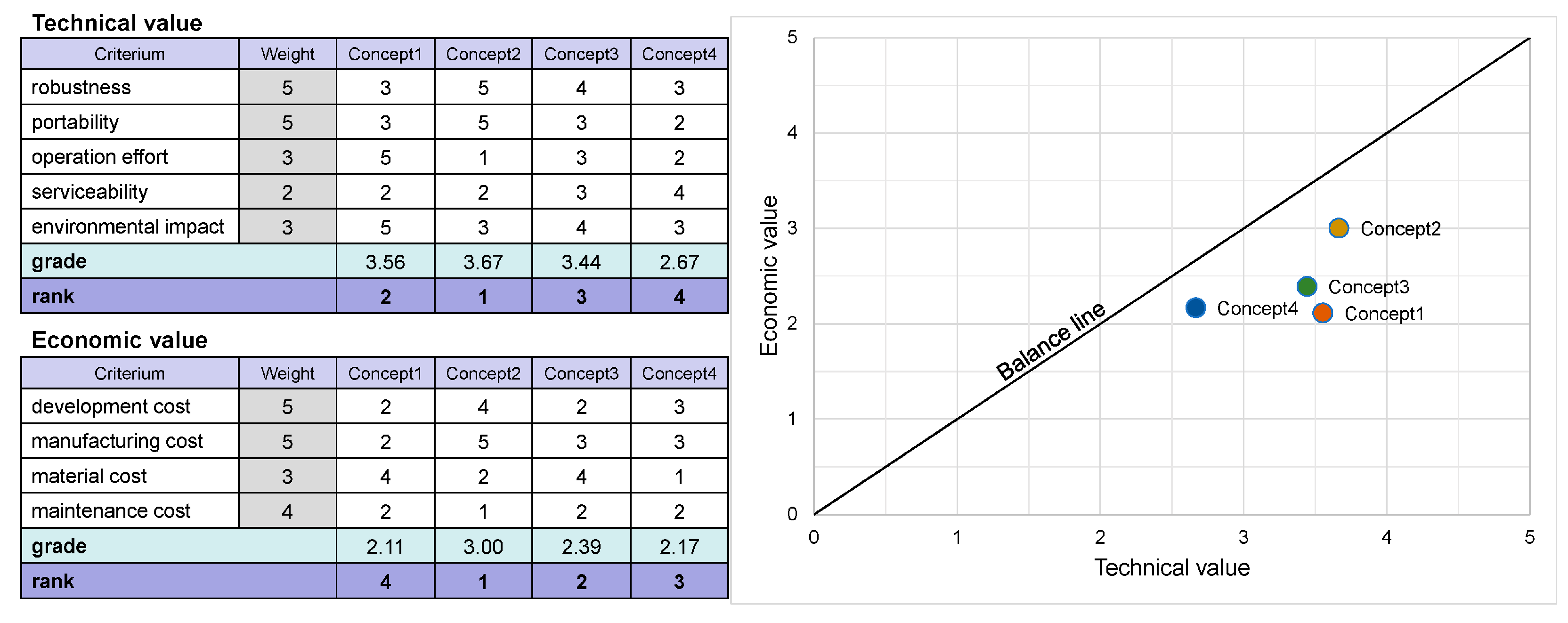
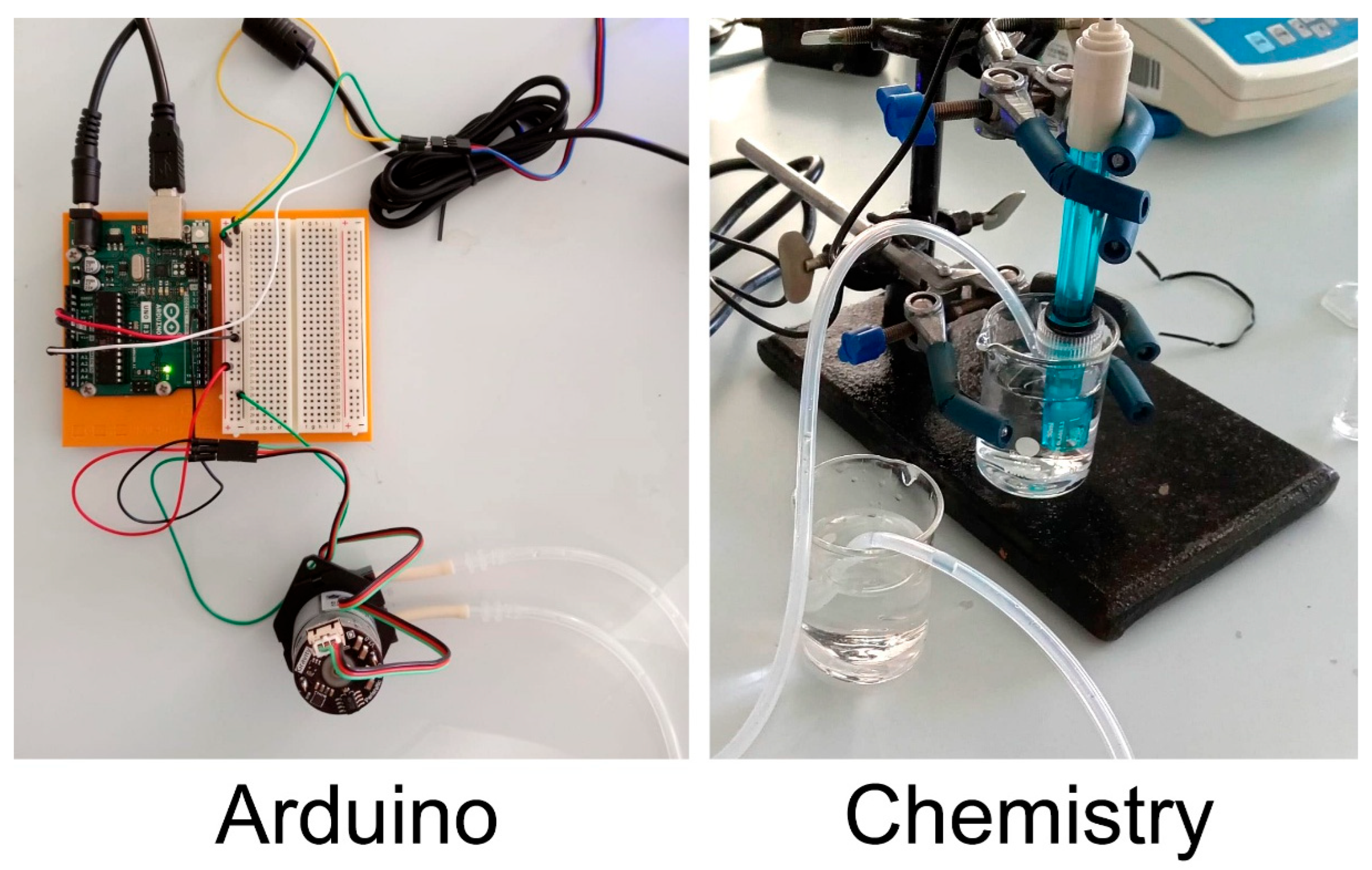
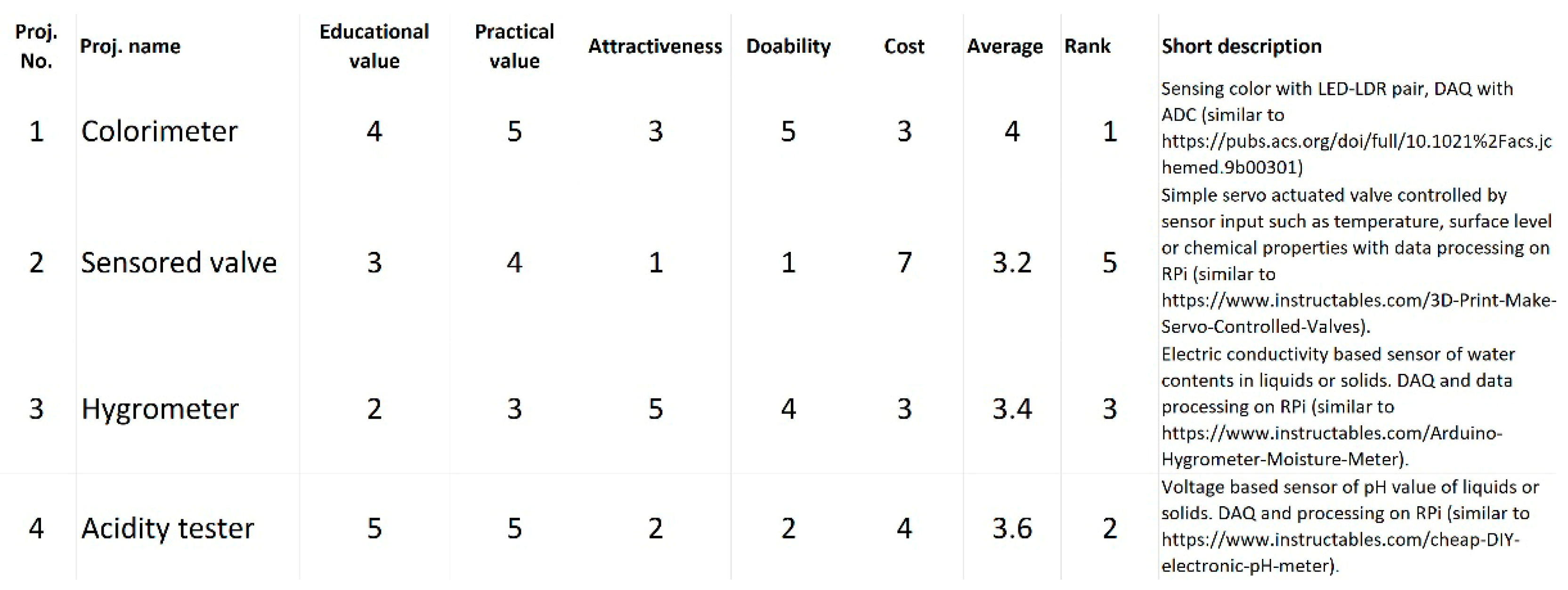
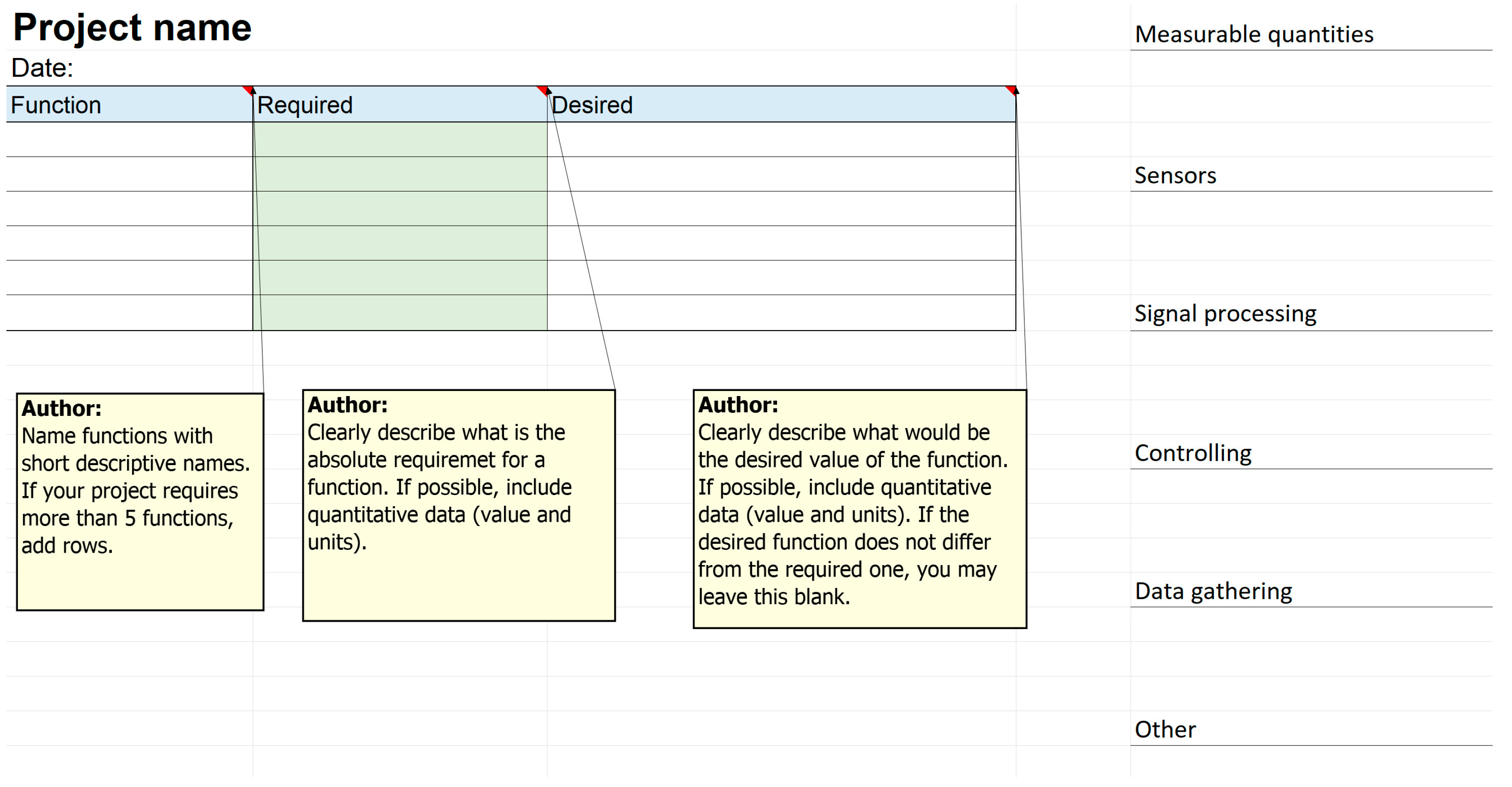
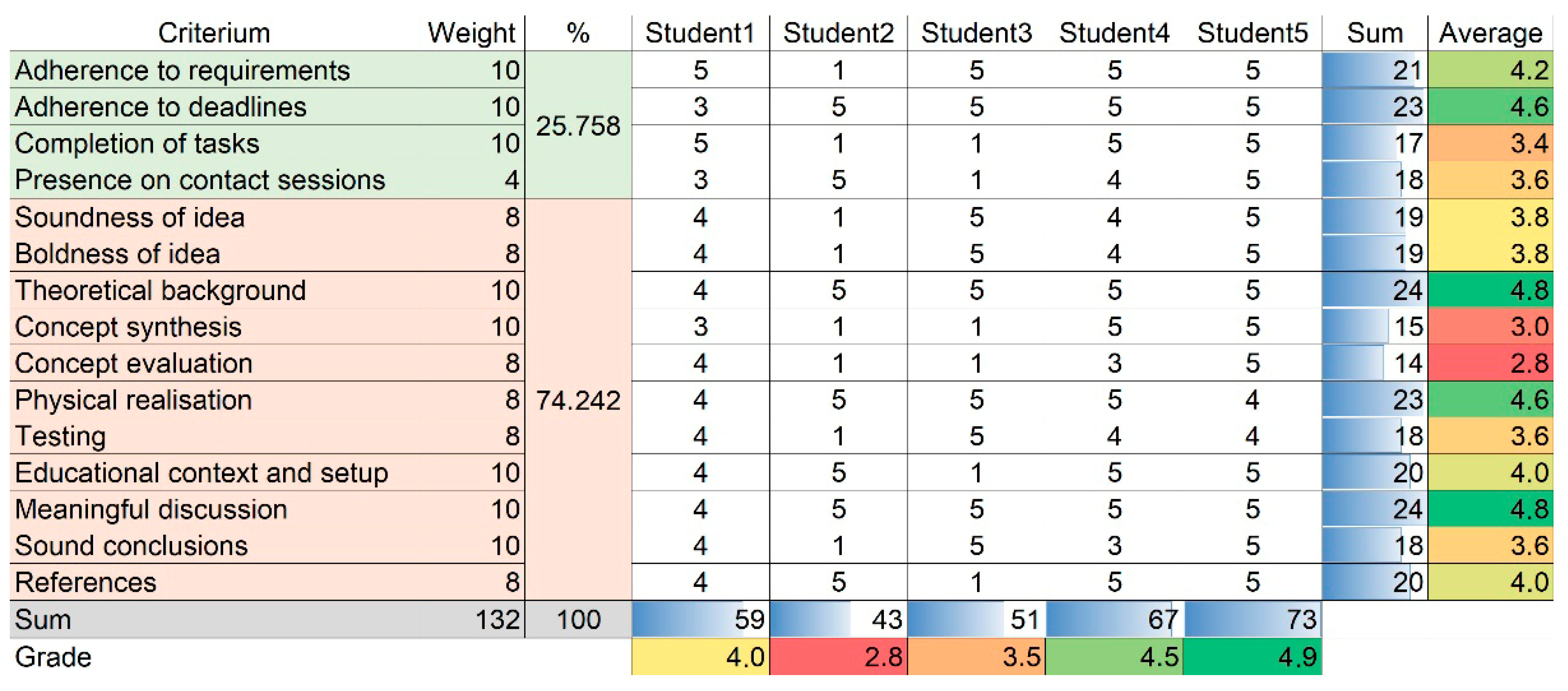
| Original Expression | Challenge | Solution or Support | Best Practices (RQ1) |
|---|---|---|---|
| “Probably the most difficult was just to pick the subject you’re going to work on.” R3 | Selecting the chemistry context is difficult | A list of reference projects collected from the research literature | Supporting the selection of the design context |
| Numerical Grade | Descriptive Grade | State of Work |
|---|---|---|
| 0 | Insufficient | Does not meet the minimum standards |
| 1 | Sufficient | Meets but does not exceed the minimum standards |
| 2 | Satisfactory | Meets and in some ways exceeds the minimum standards |
| 3 | Good | Exceeds the minimum standards with some rather significant insufficiencies |
| 4 | Very good | Significantly exceeds the minimum standards with some minor insufficiencies |
| 5 | Excellent | Exceeds the minimum standards in every criterion without any significant insufficiencies |
Disclaimer/Publisher’s Note: The statements, opinions and data contained in all publications are solely those of the individual author(s) and contributor(s) and not of MDPI and/or the editor(s). MDPI and/or the editor(s) disclaim responsibility for any injury to people or property resulting from any ideas, methods, instructions or products referred to in the content. |
© 2025 by the authors. Licensee MDPI, Basel, Switzerland. This article is an open access article distributed under the terms and conditions of the Creative Commons Attribution (CC BY) license (https://creativecommons.org/licenses/by/4.0/).
Share and Cite
Pernaa, J.; Ambrož, M.; Haatainen, O. Pedagogical Resources for Conducting STEM Engineering Projects in Chemistry Teacher Education: A Design-Based Research Approach. Educ. Sci. 2025, 15, 1196. https://doi.org/10.3390/educsci15091196
Pernaa J, Ambrož M, Haatainen O. Pedagogical Resources for Conducting STEM Engineering Projects in Chemistry Teacher Education: A Design-Based Research Approach. Education Sciences. 2025; 15(9):1196. https://doi.org/10.3390/educsci15091196
Chicago/Turabian StylePernaa, Johannes, Miha Ambrož, and Outi Haatainen. 2025. "Pedagogical Resources for Conducting STEM Engineering Projects in Chemistry Teacher Education: A Design-Based Research Approach" Education Sciences 15, no. 9: 1196. https://doi.org/10.3390/educsci15091196
APA StylePernaa, J., Ambrož, M., & Haatainen, O. (2025). Pedagogical Resources for Conducting STEM Engineering Projects in Chemistry Teacher Education: A Design-Based Research Approach. Education Sciences, 15(9), 1196. https://doi.org/10.3390/educsci15091196








